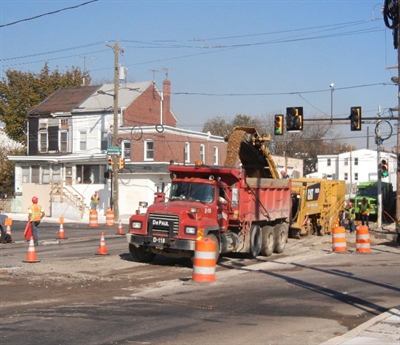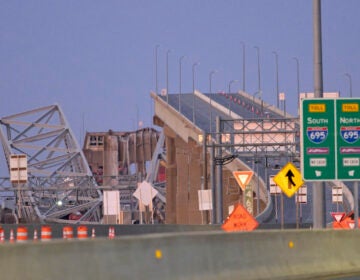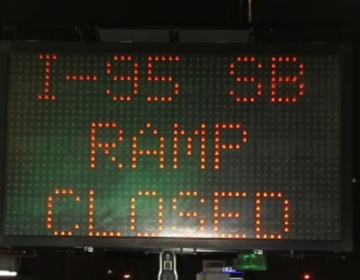An I-95 construction update

Preliminary work has begun on the Port Richmond portion of the I-95 renewal project. Trolley service on Richmond Street is now expected to be temporarily replaced by buses sometime in 2011, rather than next year as originally planned.
The heart of this portion of the project, officially called GR1 – for Girard Avenue, Section 1 – is the reconstruction of Delaware Avenue and Richmond Street and rehabilitation of the Girard Avenue bridge over the Aramingo Avenue northbound spur, which itself was just constructed in 2010 as part of GR0.
“Richmond Street and Delaware Avenue are being picked up and moved 60 feet east, so everything underneath comes with,” said Chuck Davies, PennDOT’s engineer in charge of design for District 6. But the first 18 months or so of the five-year construction cycle will mostly be comprised of utility work. “We are trying to communicate to people that it is going to be a long time before they see the new streetscape,” Davies said.
So far, the work on Richmond Street and Delaware Avenue has mostly consisted of taking down trees and brush. Once the trolley stops operating, a traffic island will be removed, said PennDOT Project Manager Elaine Elbich.
Work on the Girard Avenue Bridge will have no impact on eastbound traffic, but flow on westbound Girard Avenue will be detoured between Richmond and Fletcher streets.
Further north, work is wrapping up on the first portion of the Cottman-Princeton Interchange project – that is, CP1 – in Northeast Philadelphia. “This consists of improvements to Cottman, Princeton and State Road, and building two ramps,” said PennDOT spokesman Gene Blaum. The roughly $32 million project will be finished by the end of the year, he said.
All of the I-95 work so far has been on surface streets and roads and highway ramps, not on the elevated portions of the I-95 itself. That will change in 2012. Bids for the $200 million highway portion of the Cottman-Princeton Interchange project – CP2 – are set to go out in December, with construction beginning in the spring.
Bids for GR2, the Fishtown portion of the Girard Avenue Interchange project, running from just south of Shackamaxon to just north of Columbia, will be opened in mid-2012, with construction expected to begin in the fall.
There are many more projects planned for 2013 and beyond to revamp I-95 through Philadelphia – see the 95 Revive website for tons of maps and other information. Some design work has begun on the earliest of them, Elbich and Davies said. But with the economy the way it is, and the bulk of the money slated to come from federal sources, nothing is certain beyond GR2 and CP2, which are already funded, Davies said.
“If there is an interruption in funding, if the level is not what we assumed, all of these things could disrupt the schedule as we now see it,” he said.
The total cost for the Girard Avenue Interchange Project, parts 0 through 5: $1.2 billion. Only about 14 percent of that money is in hand, Davies said. In addition to the money needed to finish GR1-5, PennDOT requires an estimated $900 million to do three projects around the Bridge Street, Betsy Ross Bridge/Aramingo Avenue, and Allegheny/Castor avenue interchanges, Davies said. Again, most of that anticipated money would come from Washington.
If the epected funding comes through, construction would begin on GR3 in late 2013, GR4 in late 2016 and GR5 in 2017. GR3 includes I-95 northbound from Palmer to Ann streets, the northbound on and off ramps, and Delaware Avenue from Columbia to Aramingo, including bridges. GR4 includes the same stretch of I-95, southbound, the southbound ramps, and Aramingo Avenue from Delaware Avenue to York Street. GR5 includes the highway from Race to Shackamaxon streets, and Vine Street interchange ramp improvements.
Construction is set to start on the BRI portion of the project in early 2014. This includes improving the Betsy Ross Bridge/Aramingo Avenue interchange and widening and reconstructing I-95 and its bridges from Orthodox Street to Wheatsheaf Lane.
Work is set to begin on the BSR section in 2015. This project includes improvements to the Bridge Street interchange and the widening and reconstructing of 2.1 miles of I-95 and its bridges from Levick to Orthodox Street.
The AFC portion, where work is set to start in 2016, includes reconstructing I-95 and its bridges from Wheatsheaf Lane to Ann Street – from the Besty Ross Bridge Interchange to the Allegheny/Castor Avenue Interchange.
The AFC portion’s design will have to take into account some interesting conditions, Davies said. There will be many discussions with the nearby Tioga Marine Terminal, which will need to maintain access to the highway throughout construction, he said. And then there’s Monkevich Playground. “The highway splits the playground in half,” Davies said. “It’s obvious that something should be done to fix it, so that (the community has) access to both halves.”
For each project section, PennDOT has met or will meet with representatives of neighborhood agencies, city departments, and community groups. The assemblages are called Sustainable Action Committees, and the goal is to determine ways that PennDOT’s projects can best be made to fit in with community plans for those areas. If a neighborhood wants to build a park beneath an overpass, for example, PennDOT may be able to do landscaping or lighting that fits in with those plans.
The first meeting of the Sustainable Action Committee for the GR3 and GR4 sections is likely to happen next spring. “We will talk about reuse of space under the highway, lighting, trees, landscaping, access points and pedestrian issues,” Elbich said.
Since GR3 and GR4 cover so much territory, there will likely be additional meetings focused on smaller portions of the project area following the initial sessions, Elbich said.
At earlier meetings of the Girard Avenue Interchange Sustainability Committee, it was decided to save materials from the former Cramp Shipyard building, torn down to make way for the highway, and make them available for use by the city, neighborhood groups, the Delaware River Waterfront Corporation and PennDOT.
Elbich anticipates that some pieces will be used in the DRWC’s Columbia Avenue Connector project, which aims to better link Fishtown to Penn Treaty Park via Columbia in the same way that the Race Street Connector links Old City to the Race Street Pier. PennDOT also hopes to use some of the large pieces – like the old cranes – to create planters and other landscape features around Columbia, Shackamaxon and Marlborough. Community groups will begin claiming smaller pieces – such as window sashes – in 2012, Elbich said.
Reach the reporter at kgates@planphilly.com.
WHYY is your source for fact-based, in-depth journalism and information. As a nonprofit organization, we rely on financial support from readers like you. Please give today.






